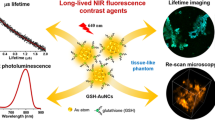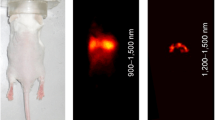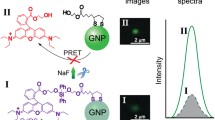Abstract
In this study, we developed a highly sensitive dual-mode imaging system using gold nanoparticles (GNPs) conjugated to various fluorophores in solid phantoms. The system consists of fluorescence-lifetime imaging microscopy (FLIM) for surface imaging, diffusion reflection (DR) for deep-tissue imaging (up to 1 cm), and metal-enhanced fluorescence (MEF). We detected quenching in the fluorescent intensity (FI) for the conjugation of both gold nanospheres (GNS) and gold nanorods (GNRs) to Fluorescein, which has an excitation peak at a wavelength shorter than the surface plasmon resonance (SPR) of both types of GNPs. Enhanced FI was detected in conjugation to Rhodamine B (RhB) and Sulforhodamine B (SRB), both with excitation peaks in the SPR regions of the GNPs. The enhanced FI was detected both in solution and in solid phantoms by the FLIM measurements. DR measurements detected the presence of GNRs within the solid phantoms by recording the dropped rates of light scattering in wavelengths corresponding to the absorption spectra of the GNRs. With the inclusion of MEF, this promising dual-mode imaging technique enables efficient and sensitive molecular and functional imaging.

Similar content being viewed by others
References
Cao, Y. C.; Jin, R. C.; Mirkin, C. A. Nanoparticles with Raman spectroscopic fingerprints for DNA and RNA detection. Science 2002, 297, 1536–1540.
Rosi, N. L.; Mirkin, C. A. Nanostructures in biodiagnostics. Chem. Rev. 2005, 105, 1547–1562.
Nie, S. M.; Xing, Y.; Kim, G. J.; Simons, J. W. Nanotechnology applications in cancer. Annu. Rev. Biomed. Eng. 2007, 9, 257–288.
Eghtedari, M.; Liopo, A. V.; Copland, J. A.; Oraevsky, A. A.; Motamedi, M. Engineering of hetero-functional gold nanorods for the in vivo molecular targeting of breast cancer cells. Nano Lett. 2009, 9, 287–291.
Von Maltzahn, G.; Park, J. H.; Agrawal, A.; Bandaru, N. K.; Das, S. K.; Sailor, M. J.; Bhatia, S. N. Computationally guided photothermal tumor therapy using long-circulating gold nanorod antennas. Cancer Res. 2009, 69, 3892–3900.
El-Sayed, M. A. Some interesting properties of metals confined in time and nanometer space of different shapes. Acc. Chem. Res. 2001, 34, 257–264.
Jain, P. K.; Lee, K. S.; El-Sayed, I. H.; El-Sayed, M. A. Calculated absorption and scattering properties of gold nanoparticles of different size, shape, and composition: Applications in biological imaging and biomedicine. J. Phys. Chem. B 2006, 110, 7238–7248.
Zhang, Y. N.; Yu, J.; Birch, D. J. S.; Chen, Y. Gold nanorods for fluorescence lifetime imaging in biology. J. Biomed. Opt. 2010, 15, 020504.
Copland, J. A.; Eghtedari, M.; Popov, V. L.; Kotov, N.; Mamedova, N.; Motamedi, M.; Oraevsky, A. A. Bioconjugated gold nanoparticles as a molecular based contrast agent: Implications for imaging of deep tumors using optoacoustic tomography. Mol. Imaging Biol. 2004, 6, 341–349.
Qian, X.; Peng, X.-H.; Ansari, D. O.; Yin-Goen, Q.; Chen, G. Z.; Shin, D. M.; Yang, L.; Young, A. N.; Wang, M. D.; Nie, S. In vivo tumor targeting and spectroscopic detection with surface-enhanced Raman nanoparticle tags. Nat. Biotechnol. 2008, 26, 83–90.
Robinson, J. T.; Welsher, K.; Tabakman, S. M.; Sherlock, S. P.; Wang, H. L.; Luong, R.; Dai, H. J. High performance in vivo near-IR (>1 µm) imaging and photothermal cancer therapy with carbon nanotubes. Nano Res. 2010, 3, 779–793.
Reuveni, T.; Motiei, M.; Romman, Z.; Popovtzer, A.; Popovtzer, R. Targeted gold nanoparticles enable molecular CT imaging of cancer: An in vivo study. Int. J. Nanomedicine 2011, 6, 2859–2864.
Fixler, D.; Nayhoz, T.; Ray, K. Diffusion reflection and fluorescence lifetime imaging microscopy study of fluorophore-conjugated gold nanoparticles or nanorods in solid phantoms. ACS Photonics 2014, 1, 900–905.
Subhash, N.; Mallia, J. R.; Thomas, S. S.; Mathews, A.; Sebastian, P.; Madhavan, J. Oral cancer detection using diffuse reflectance spectral ratio R540/R575 of oxygenated hemoglobin bands. J. Biomed. Opt. 2006, 11, 014018.
McMurdy, J.; Jay, G.; Suner, S.; Crawford, G. Photonicsbased in vivo total hemoglobin monitoring and clinical relevance. J. Biophotonics 2009, 2, 277–287.
Ankri, R.; Taitelbaum, H.; Fixler, D. Reflected light intensity profile of two-layer tissues: Phantom experiments. J. Biomed. Opt. 2011, 16, 085001.
Ankri, R.; Taitelbaum, H.; Fixler, D. On phantom experiment of the photon migration model in tissues. Open Opt. J. 2011, 5, 28–32.
Ankri, R.; Duadi, H.; Motiei, M.; Fixler, D. In-vivo tumor detection using diffusion reflection measurements of targeted gold nanorods—Aquantitative study. J. Biophotonics 2012, 5, 263–273.
Ankri, R.; Peretz, V.; Motiei, M.; Popovtzer, R.; Fixler, D. A new method for cancer detection based on diffusion reflection measurements of targeted gold nanorods. Int. J. Nanomedicine 2012, 7, 449–455.
Fixler, D.; Ankri, R. Subcutaneous gold nanorods [corrected] detection with diffusion reflection measurement. J. Biomed. Opt. 2013, 18, 61226.
Ankri, R.; Leshem-Lev, D.; Fixler, D.; Popovtzer, R.; Motiei, M.; Kornowski, R.; Hochhauser, E.; Lev, E. I. Gold nanorods as absorption contrast agents for the noninvasive detection of arterial vascular disorders based on diffusion reflection measurements. Nano Lett. 2014, 14, 2681–2687.
Lakowicz, J. R. Principles of Fluorescence Spectroscopy, 3rd ed.; Springer: New York, NY, 2006.
Becker, W. Fluorescence lifetime imaging—Techniques and applications. J. Microsc. 2012, 247, 119–136.
Lakowicz, J. R. Radiative decay engineering 5: Metalenhanced fluorescence and plasmon emission. Anal. Biochem. 2005, 337, 171–194.
Ray, K.; Szmacinski, H.; Enderlein, J.; Lakowicz, J. R. Distance dependence of surface plasmon-coupled emission observed using Langmuir-Blodgett films. Appl. Phys. Lett. 2007, 90, 251116.
Ray, K.; Badugu, R.; Lakowicz, J. R. Polyelectrolyte layer-bylayer assembly to control the distance between fluorophores and plasmonic nanostructures. Chem. Mater. 2007, 19, 5902–5909.
Ray, K.; Zhang, J.; Lakowicz, J. R. Fluorescence lifetime correlation spectroscopic study of fluorophore-labeled silver nanoparticles. Anal. Chem. 2008, 80, 7313–7318.
Kobayashi, H.; Choyke, P. L. Target-cancer-cell-specific activatable fluorescence imaging probes: Rational design and in vivo applications. Acc. Chem. Res. 2011, 44, 83–90.
Drake, C. R.; Miller, D. C.; Jones, E. F. Activatable optical probes for the detection of enzymes. Curr. Org. Synth. 2011, 8, 498–520.
Li, X. H.; Gao, X. H.; Shi, W.; Ma, H. M. Design strategies for water-soluble small molecular chromogenic and fluorogenic probes. Chem. Rev. 2014, 114, 590–659.
Lavis, L. D.; Raines, R. T. Bright building blocks for chemical biology. ACS Chem. Biol. 2014, 9, 855–866.
Prost, M.; Hasserodt, J. “Double gating”—A concept for enzyme-responsive imaging probes aiming at high tissue specificity. Chem. Commun. 2014, 50, 14896–14899.
Razgulin, A.; Ma, N.; Rao, J. H. Strategies for in vivo imaging of enzyme activity: An overview and recent advances. Chem. Soc. Rev. 2011, 40, 4186–4216.
Hutter, E.; Maysinger, D. Gold-nanoparticle-based biosensors for detection of enzyme activity. Trends Pharmacol. Sci. 2013, 34, 497–507.
Zhang, J. M.; Li, C.; Zhang, X.; Huo, S. D.; Jin, S. B.; An, F. F.; Wang, X. D.; Xue, X. D.; Okeke, C. I.; Duan, G. Y. et al. In vivo tumor-targeted dual-modal fluorescence/CT imaging using a nanoprobe co-loaded with an aggregation-induced emission dye and gold nanoparticles. Biomaterials 2015, 42, 103–111.
Cheng, W.; Chen, Y. L.; Yan, F.; Ding, L.; Ding, S. J.; Ju, H. X.; Yin, Y. B. Ultrasensitive scanometric strategy for detection of matrix metalloproteinases using a histidine tagged peptide-Au nanoparticle probe. Chem. Commun. 2011, 47, 2877–2879.
Park, S. Y.; Lee, S. M.; Kim, G. B.; Kim, Y. P. Gold nanoparticle-based fluorescence quenching via metal coordination for assaying protease activity. Gold Bull. 2012, 45, 213–219.
Tira, D. S.; Focsan, M.; Ulinici, S.; Maniu, D.; Astilean, S. Rhodamine B-coated gold nanoparticles as effective “turn-on” fluorescent sensors for detection of zinc II ions in water. Spectrosc. Lett. 2014, 47, 153–159.
Mohamed, M. B.; Volkov, V.; Link, S.; El-Sayed, M. A. The “lightning” gold nanorods: Fluorescence enhancement of over a million compared to the gold metal. Chem. Phys. Lett. 2000, 317, 517–523.
Geddes, C. D.; Lakowicz, J. R. Editorial: Metal-enhanced fluorescence. J. Fluoresc. 2002, 12, 121–129.
Ming, T.; Zhao, L.; Yang, Z.; Chen, H. J.; Sun, L. D.; Wang, J. F.; Yan, C. H. Strong polarization dependence of plasmonenhanced fluorescence on single gold nanorods. Nano Lett. 2009, 9, 3896–3903.
Abadeer, N. S.; Brennan, M. R.; Wilson, W. L.; Murphy, C. J. Distance and plasmon wavelength dependent fluorescence of molecules bound to silica-coated gold nanorods. ACS Nano 2014, 8, 8392–8406.
Kang, K. A.; Wang, J. T. Smart dual-mode fluorescent gold nanoparticle agents. Wiley Interdiscip. Rev.: Nanomed. Nanobiotechnol. 2014, 6, 398–409.
Enüstün, B. V.; Turkevich, J. Coagulation of colloidal gold. J. Am. Chem. Soc. 1963, 85, 3317–3328.
Nikoobakht, B.; El-Sayed, M. A. Preparation and growth mechanism of gold nanorods (NRs) using seed-mediated growth method. Chem. Mater. 2003, 15, 1957–1962.
Sau, T. K.; Murphy, C. J. Seeded high yield synthesis of short Au nanorods in aqueous solution. Langmuir 2004, 20, 6414–6420.
Author information
Authors and Affiliations
Corresponding authors
Rights and permissions
About this article
Cite this article
Barnoy, E.A., Fixler, D., Popovtzer, R. et al. An ultra-sensitive dual-mode imaging system using metal-enhanced fluorescence in solid phantoms. Nano Res. 8, 3912–3921 (2015). https://doi.org/10.1007/s12274-015-0891-y
Received:
Revised:
Accepted:
Published:
Issue Date:
DOI: https://doi.org/10.1007/s12274-015-0891-y




